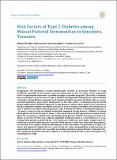| dc.description.abstract | Background: The prevalence of non-communicable diseases in particular diabetes is rising
worldwide especially in low income countries. Information on the risk factors at the community
level is of paramount importance to enable strategic preventive programs. This study is undertaken
to investigate the prevalence of Type 2 diabetes and Impaired Fasting Glucose and associated
risk factors among Maasai communities of Simanjiro District, Tanzania. Methods: This is a crosssectional
population based study. Information on the risk factors is obtained using the World
Health Organization STEPWISE approach. Target group are Maasai adults aged 25 years and above
living in Simanjiro District. Descriptive statistics is used to explore prevalence and risk factors of
Type 2 diabetes and impaired fasting glucose. Type 2 diabetes is defined as fasting blood glucose ≥
7.0 mmol/L and/or being on diabetic medication. Impaired Fasting Glucose is defined as fasting
blood glucose between 5.6 and 6.9 mmol/L. Pearson correlation and regression are used to investigate
the association of risk factors with fasting blood glucose. Results: Prevalence of Type 2 diabetes
is at 0.9% (95%CI; [0.3, 2.1]) and impaired fasting tolerance at 2.4% (95%CI; [1.3, 4.1]).
Fasting blood glucose is positively (p < 0.05) associated with body mass index, weight, waist circumference,
systolic blood pressure, diastolic blood pressure, heart rate, main work but negatively
associated with number of fruit intake days per week. Conclusion: The prevalence of Type 2 diabetes
and Impaired Fasting Glucose is low in this particular sub-population which presents an
opportunity for prevention. For successful prevention of diabetes among Maasai in Simanjiro District,
programs should be tailored on reduction of obesity, blood pressure, and encouragement of
consumption of fruits. | en_US |

